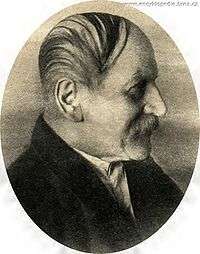Jindřich Wankel
Jindřich Wankel (German: Heinrich Wankel; July 15, 1821, Prague – April 5, 1897, Olomouc) was a Bohemian palaeontologist and archaeologist.

Wankel was born to Damian Wankel, a clerk, and his wife Magdalena, née Schwarz in a bilingual environment. He was attending German schools in Prague and later studied Medicine at the University of Prague as a student of Josef Hyrtl.
He came to work into area of Moravský kras (Moravian Karst, today Czech Republic) in 1847 and since 1849 lived in Blansko as a medical doctor. He started with geological exploration of the area and later with palaeontology, archaeology and anthropology.
In 1850, in Blansko, he set up first ever laboratory to research fossil bones from Cenozoic Era where he assembled complete skeleton of cave bear (until then such bones were used for spodium in nearby sugar refinery ). His most famous discovery (1872) was burial site of a nobleman from Bronze Age at Býčí skála, with skeletons of 40 ritually killed young women (, ).
His grandson Karel Absolon was also famous archaeologist and worked in the same area.
Works (selection)
- Der Menschenknochenfund in der Býčískálahöhle ("The human bones found in the Býčí skála Cave") (Vienna 1871)
- Prähistorische Eisenschmelz- und Schmiedestätten in Mähren ("Prehistoric iron smelting and forging facilities in Moravia") (Vienna 1879)
- Bilder aus der Mährischen Schweiz und ihrer Vergangenheit ("Images from the Moravian Switzerland and their past") (Vienna 1882)
- Beitrag zur Geschichte der Slaven in Europa ("Contribution to the history of the Slavs in Europe") (Olomouc 1885)